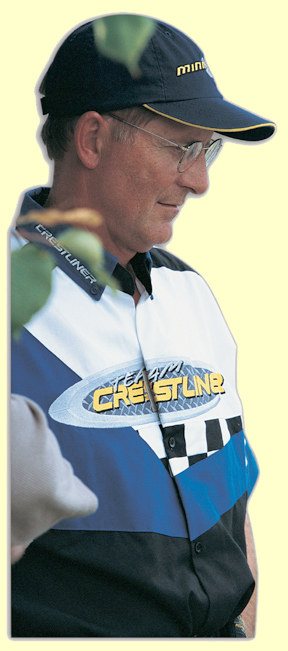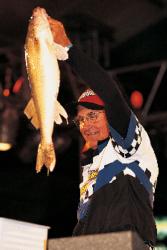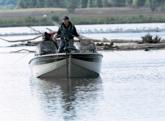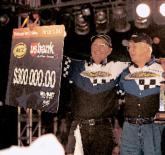Structured

Bruce Samson’s understanding of structure has paid off handsomely
“I fish…fish,” said Bruce Samson in a simplistic, matter-of-fact sort of way. His premise surely isn’t brain surgery, either, but after hearing the good doc explain further, you get the feeling he’s taking you places you’ve never been before.
Let’s backtrack momentarily, though, and profile the man his peers call Doc. He is actually Dr. Bruce Samson, M.D., a medical doctor who resides in Minnetrista, Minn., a western suburb of Minneapolis. He began practicing family medicine in 1976 and swung to urgent care and the emergency room in 1991. He then relinquished it all in the spring of 2002 to forge a new career in tournament fishing, taking it beyond “obsessive hobby” status. Prior to the transformation, Samson fished competitively, too, and to great success, but medicine always got in the way.
Since the epiphany, full-time angling has paid rather handsomely. Just last fall, Samson earned a $300,000 payday by winning the Wal-Mart RCL Walleye Championship on the Mississippi River in Red Wing, Minn. And once that gaudy figure was tallied with his prior earnings, soft-spoken Samson immediately became the biggest money winner in professional walleye-fishing history.
Samson has prevailed in bites ranging from planer boards and Shad Raps to weedlines and Roach Rigs. But when bite comes to chomp, Samson is a student of structure. And sometimes, in tournament play, structure stands between him and the podium. No other obstacle can be as systematically dismantled, though. Being a full-time doctor was an obstacle; structure isn’t.
Samson’s philosophy concerning structure-fishing is founded on keeping the bait in a fish’s face for extended periods. Elementary, you say? Not really. Long-term carrot-dangling can only occur if you first know how to locate fish – in this scenario, on structure – and afterward cling to them like lint.
“I put bait in front of fish more often than most anglers,” Sampson said with the confidence one would expect from a physician. “If I’m in front of the fish 2 percent of the time and you’re at 1 percent, I have twice as good a chance of catching more fish. Subtle differences give me that 1 percent advantage, too.”
Samson contends that too few anglers “stop on fish” instead of hastily trolling or drifting through fishy areas. Sure, they’ll pop an aggressor or two, but they’ll miss exponentially more fish by not pausing to dismember the spot.
Truthfully, Samson “doesn’t like to move.” He’d rather camp on known, but fussy, walleyes than freelance into the unknown. There’s a time-honored adage in fishing that says, “You never leave fish to find fish.” It’s a mantra for Samson.
Structure fishing is his strength. Crankbait conditions and open-water bites, Samson admits, are his Achilles’ heels, although he’s performed admirably in these areas, too. He has more confidence, though, when fish are relating to structure. “I have an ability to visualize structure (and know) where fish are in relationship to it,” he said. “I’m able to picture what it would look like if the lake was drained.”
In order to envision what structure looks like, Samson – who dubs himself a Map Man – says anglers need a deep appreciation and comprehension of hydrological maps and then be able to coordinate mapping skills with an on-the-water mastery of electronics.
 Two winters ago, prior to an event on Minnesota’s Leech Lake, Samson spent more than 20 hours mapping on his computer, at home, in his pajamas. “I earmarked all sorts of structure, particularly offshore humps,” he said. He lent special attention to “points,” “any right angle,” “the highest place,” and “every single corner” a hump had to offer.
Two winters ago, prior to an event on Minnesota’s Leech Lake, Samson spent more than 20 hours mapping on his computer, at home, in his pajamas. “I earmarked all sorts of structure, particularly offshore humps,” he said. He lent special attention to “points,” “any right angle,” “the highest place,” and “every single corner” a hump had to offer.
This pre-fishing/cyber-mapping is made possible by outfits like LakeMaster and ReelBottom. They compose GPS-accurate contour maps that can be loaded into a laptop or desktop computer and viewed in detail. Such maps are available for many of North America’s larger and more popular waters, such as Leech Lake, Mille Lacs and the Great Lakes. Many more will be available in the coming years.
So before wetting his hull, Samson settles in front of the monitor and keypunches waypoints. Some he denotes because of their obvious walleye-harboring capabilities; they just look good, structurally speaking. Other spots come through back channels and down the pike – tips and scuttlebutt.
Once the digitized map is fully “doctored,” Samson transfers the data to his Lowrance LCX-19, an onboard GPS, which accepts Navionics chips. The combined information lays waypoints over a contour map that’s projected in liquid crystal clarity. That’s when Samson jumps in his boat for some serious research. After choosing a piece of structure, like a reef or bar, he motors across it, to and fro, examining his electronics and referencing his map until he can “see” the structure.
Marker buoys play a major role in the process, too. Samson chucks markers out onto poignant features, such as the crown, fingers and sheerest breaks. The markers help build an overall visual template by providing true dimensions.
He’ll work the searching and sounding gig for quite a while to form a detailed mental picture. But if adult-sized marks emerge on the screen, even he, an angler with the patience of the pope, must indulge. Usually that means poking around with a bubblegum Northland Fire-Ball Jig and minnow. If they’re on the take, school’s out and play begins, but if not, Samson resumes the study.
 As he continues matching waypoints to reality – assuming we’re dealing with a lake that’s been pre-mapped – Samson quickly enters new icons if the probable ones were off. Or, if a prospective spot pans out and fish are present, he changes the generic, square icon to a much more gratifying fish version.
As he continues matching waypoints to reality – assuming we’re dealing with a lake that’s been pre-mapped – Samson quickly enters new icons if the probable ones were off. Or, if a prospective spot pans out and fish are present, he changes the generic, square icon to a much more gratifying fish version.
The mission to fully realize structure involves paying attention to bottom composition, too, particularly transitions from one medium to another, like sand to rock or gravel to mud. Such changeovers are exposed by alterations in the thickness of the bottom line of a flasher; thinner is harder, thicker is softer. Samson keeps an outdated but reliable Eagle flasher on the bow but backs up its findings with the real-time ability of his Lowrance X-19, which is a color liquid crystal graph-and-GPS combo. Both units can decipher bottom composition.
When he finds such a transition or other interesting irregularities in a structure, Samson locks onto his target like a fighter pilot. “I don’t want to be 10 or 20 feet away from the spot,” he said. “I’m going to camp on it.”
Typically, to maintain contact with such a spot, Samson wrestles the wind and weather head-on. He front-trolls from the bow of his Crestliner Tournament Series 202, juiced and steered by a Minn Kota Maxxum 36-volt trolling motor. “It’s got enough power to let me sit on fish, even in rough conditions,” he said.
Samson says it’s taken him about three seasons to hone the art of front-trolling. Running bow-first undeniably yields greater control, but Samson admits that it’s physically demanding. In a tournament, though, Samson sucks it up, works through the aches and pains, and keeps ice packs in his hotel room.
He does, however, throw a wrench, or should I say a scalpel, into the procedure. Samson’s transducer isn’t directed downward. Up front, on his Maxxum, the transducer is skewed somewhat forward, probing ahead of the rig.
“Having the trolling-motor-mounted transducer tilted forward lets me look to the left or right and know what direction the fish are,” Samson said. “If I point it to the right and see a mark, and the fish vanishes when I redirect the transducer to the left, I know where that fish is.”
 If it’s terribly rough, though, Samson maneuvers from the stern with his Minn Kota Vantage, another 36-volter. In the rear, because of the turbulence generated by the hull and prop, Samson can’t mount the transducer to the trolling motor, which is fine. Instead, he affixes it to the rear starboard side of the transom while the trolling motor is mounted nearer port, on the stern. Having a transducer directly underfoot provides uninterrupted appraisals of what’s happening straight below. Think of it as ice fishing from a boat. If you’ve ever pitched over a hole in the ice and watched walleyes on a flasher, you know that’s the pinnacle of control.
If it’s terribly rough, though, Samson maneuvers from the stern with his Minn Kota Vantage, another 36-volter. In the rear, because of the turbulence generated by the hull and prop, Samson can’t mount the transducer to the trolling motor, which is fine. Instead, he affixes it to the rear starboard side of the transom while the trolling motor is mounted nearer port, on the stern. Having a transducer directly underfoot provides uninterrupted appraisals of what’s happening straight below. Think of it as ice fishing from a boat. If you’ve ever pitched over a hole in the ice and watched walleyes on a flasher, you know that’s the pinnacle of control.
Given the choice, however, Samson prefers the freedom that his bow-mounted, foot-controlled Maxxum provides. He justifies the position by saying, “Both of my hands are always free. I can fight a fish or rebait and not drift off a spot. Because if you drift too far, there’s always another boat waiting around to take your place.”
Even the Good Doctor uncovers a pristine hunk of structure every now and then that doesn’t show any fish, but he knows they are there, swimming below the radar, tummies to the table, so to speak. So he stops and fishes, just to clarify the situation.
This hearkens back to Samson’s statesmanlike patience. He’ll work fish, as well as the possibility of there being fish, longer than the average angler.
“I see a lot of guys skip over fish all day long,” Samson said. “They can’t or won’t stay on them.”
A lot of boats pass by him, and all Samson offers is a good-old-boy wave backed by a grin that makes you wonder if he knows something nobody else does.